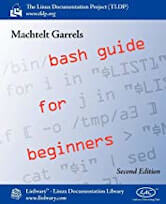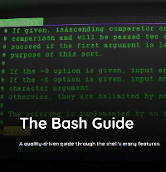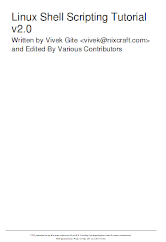Last Updated on May 22, 2022
4. Bash Guide for Beginners by Machtelt Garrels
 Everybody working on a UNIX or UNIX-like system who wants to make life easier on themselves, power users and sysadmins alike, can benefit from reading this book. Learn about Bash programming.
Everybody working on a UNIX or UNIX-like system who wants to make life easier on themselves, power users and sysadmins alike, can benefit from reading this book. Learn about Bash programming.
This is a practical guide which, while not always being too serious, tries to give real-life instead of theoretical examples.
This guide has been translated to Chinese and Ukrainian.
Explores:
- Bash scripts.
- Writing and debugging scripts.
- The bash environment: Shell initialization files, Variables, Quoting characters, Shell expansion, aliases.
- Regular expressions.
- sed stream editor.
- awk programming language.
- Conditional statements (if, if/then/else, if/then/elif/else, Nested if statements, Boolean operations).
- Writing interactive scripts.
- Repetitive tasks.
- Functions.
- Catching signals.
The book is released under an open source license.
5. The Bash Guide by Maarten Billemont
 The Bash Guide teaches both newcomers and long-time users the best, safest and most robust ways of writing powerful bash programming scripts as well as making efficient and speedy interactive use of the shell.
The Bash Guide teaches both newcomers and long-time users the best, safest and most robust ways of writing powerful bash programming scripts as well as making efficient and speedy interactive use of the shell.
The book explores:
- Inception – an introduction to bash, installing and starting it; the terminal, the keyboard and the display; programs, processes and how their flow of information is connected.
- Commands and Arguments – what a command is, and how to issue them; interactive mode and scripts; command syntax, searching commands and programs by name; arguments and word splitting as well as input and output redirection.
- Variables and Expansions – Bash parameters and variables; environment variables, special parameters and array parameters; expanding parameters, expansion operators, command substitution and process substitution; pathname expansion, tilde expansion and brace expansion.
- Tests and Conditionals – exit codes, success and failure, testing files, strings and numbers, handling different conditions, conditional operators and conditional compound commands.
This guide is open source, licensed under Creative Commons Attribution-ShareAlike 4.0 International License (CC-BY-SA). It’s a work-in-progress.
6. Linux Shell Scripting Tutorial by Vivek Gite

The book starts by describing Linux and simple scripts to automate frequently executed commands and moves on to describing conditional logic, user interaction, loops, menus, traps, and functions. The book ends with various sys administration related scripts such as making a backup, using cron jobs, writing interactive tools, web based tools, remote login, ftp and database backup related scripts.
The book is aimed at system administrators and students. It teachers the reader how to read, write, and debug Linux shell scripts using the Bash shell.
Linux Shell Scripting Tutorial is available under the Creative Commons Attribution-Noncommercial-Share Alike 3.0 Unported license.
Pages in this article:
Page 1 – GNU Bash Reference Manual and more books
Page 2 – Bash Guide for Beginners and more books
All books in this series:
| Free Programming Books | |
|---|---|
| Ada | ALGOL-like programming language, extended from Pascal and other languages |
| Agda | Dependently typed functional language based on intuitionistic Type Theory |
| Arduino | Inexpensive, flexible, open source microcontroller platform |
| Assembly | As close to writing machine code without writing in pure hexadecimal |
| Awk | Versatile language designed for pattern scanning and processing language |
| Bash | Shell and command language; popular both as a shell and a scripting language |
| BASIC | Beginner’s All-purpose Symbolic Instruction Code |
| C | General-purpose, procedural, portable, high-level language |
| C++ | General-purpose, portable, free-form, multi-paradigm language |
| C# | Combines the power and flexibility of C++ with the simplicity of Visual Basic |
| Clojure | Dialect of the Lisp programming language |
| ClojureScript | Compiler for Clojure that targets JavaScript |
| COBOL | Common Business-Oriented Language |
| CoffeeScript | Transcompiles into JavaScript inspired by Ruby, Python and Haskell |
| Coq | Dependently typed language similar to Agda, Idris, F* and others |
| Crystal | General-purpose, concurrent, multi-paradigm, object-oriented language |
| CSS | CSS (Cascading Style Sheets) specifies a web page’s appearance |
| D | General-purpose systems programming language with a C-like syntax |
| Dart | Client-optimized language for fast apps on multiple platforms |
| Dylan | Multi-paradigm language supporting functional and object-oriented coding |
| ECMAScript | Best known as the language embedded in web browsers |
| Eiffel | Object-oriented language designed by Bertrand Meyer |
| Elixir | Relatively new functional language running on the Erlang virtual machine |
| Erlang | General-purpose, concurrent, declarative, functional language |
| F# | Uses functional, imperative, and object-oriented programming methods |
| Factor | Dynamic stack-based programming language |
| Forth | Imperative stack-based programming language |
| Fortran | The first high-level language, using the first compiler |
| Go | Compiled, statically typed programming language |
| Groovy | Powerful, optionally typed and dynamic language |
| Haskell | Standardized, general-purpose, polymorphically, statically typed language |
| HTML | HyperText Markup Language |
| Icon | Wide variety of features for processing and presenting symbolic data |
| J | Array programming language based primarily on APL |
| Java | General-purpose, concurrent, class-based, object-oriented, high-level language |
| JavaScript | Interpreted, prototype-based, scripting language |
| Julia | High-level, high-performance language for technical computing |
| Kotlin | More modern version of Java |
| LabVIEW | Designed to enable domain experts to build power systems quickly |
| LaTeX | Professional document preparation system and document markup language |
| Lisp | Unique features - excellent to study programming constructs |
| Logo | Dialect of Lisp that features interactivity, modularity, extensibility |
| Lua | Designed as an embeddable scripting language |
| Markdown | Plain text formatting syntax designed to be easy-to-read and easy-to-write |
| Objective-C | Object-oriented language that adds Smalltalk-style messaging to C |
| OCaml | The main implementation of the Caml language |
| Pascal | Imperative and procedural language designed in the late 1960s |
| Perl | High-level, general-purpose, interpreted, scripting, dynamic language |
| PHP | PHP has been at the helm of the web for many years |
| PostScript | Interpreted, stack-based and Turing complete language |
| Prolog | A general purpose, declarative, logic programming language |
| PureScript | Small strongly, statically typed language compiling to JavaScript |
| Python | General-purpose, structured, powerful language |
| QML | Hierarchical declarative language for user interface layout - JSON-like syntax |
| R | De facto standard among statisticians and data analysts |
| Racket | General-purpose, object-oriented, multi-paradigm, functional language |
| Raku | Member of the Perl family of programming languages |
| Ruby | General purpose, scripting, structured, flexible, fully object-oriented language |
| Rust | Ideal for systems, embedded, and other performance critical code |
| Scala | Modern, object-functional, multi-paradigm, Java-based language |
| Scheme | A general-purpose, functional language descended from Lisp and Algol |
| Scratch | Visual programming language designed for 8-16 year-old children |
| SQL | Access and manipulate data held in a relational database management system |
| Standard ML | General-purpose functional language characterized as "Lisp with types" |
| Swift | Powerful and intuitive general-purpose programming language |
| Tcl | Dynamic language based on concepts of Lisp, C, and Unix shells |
| TeX | Markup and programming language - create professional quality typeset text |
| TypeScript | Strict syntactical superset of JavaScript adding optional static typing |
| Vala | Object-oriented language, syntactically similar to C# |
| VHDL | Hardware description language used in electronic design automation |
| VimL | Powerful scripting language of the Vim editor |
| XML | Rules for defining semantic tags describing structure ad meaning |
